|
Raptors are, in a nutshell, birds of prey. Raptors comprise an artificial grouping of two unrelated orders of birds, the Falconiformes which are diurnal, or day-active, predatory birds and the Strigiformes which are all the world’s owls. Overall, the Falconiformes exhibit a wide variety of forms, from small kestrels to large eagles, as well as exhibiting a wide variety of biological specialization. What follows is a brief summation of some of the different groups of diurnal raptors including species that can be observed in Redwood national and State Parks. 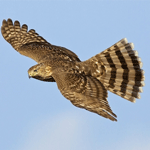
NPS Accipiters are a group of hawks designed for woodland habitats although as with other raptors, they may be seen in open country habitats too. Relatively short, rounded wings and a long tail allow an accipiter to maneuver through a forest and its shrub understory. There are three species of accipiter in North America, two of which may be seen regularly in Redwood National and State Park: Sharp-shinned Hawk (Accipiter striatus) and Cooper’s Hawk (Accipiter cooperii). Although these two are not easily told apart by size or plumage, a couple of things to look for when seen flying overhead are the size of the head and the shape of the tail. A Cooper’s Hawk has a larger head that sticks out from the body, compared to the small head and neck of a Sharp-shinned. Look for a squared-off tail tip on the “Sharpie” and a rounded tail on a Cooper’s. 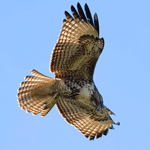
NPS Buteos are larger, chunkier hawks, seen primarily in open country. In Redwood National and State Parks, there are two resident buteos: Red-tailed Hawk (Buteo jamaicensis) and the smaller Red-shouldered Hawk (Buteo lineatus). Both of these hawks are readily visible from roadsides, either perching on trees or poles or circling above. Most years there is at least one Rough-legged Hawk (Buteo lagopus), a large eye-catching buteo, that decides to spend the winter in the parks. Look for it around patches of oaks in the Bald Hills. 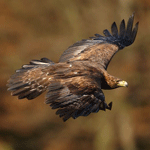
USFWS Eagles are similar to buteos in overall appearance except for one thing: they are huge! A Red-tailed Hawk may appear pretty big, until it gets next to an eagle. Nothing locally compares in size with these magnificent birds. In Redwood national and State Parks, it’s common to see a Bald Eagle (Haliaeetus leucocephalus), both the white-headed adults and mottled subadults occur here. Bald eagles nest in the parks and may be observed hunting over lagoons and rivers, they also feed on a fair amount of carrion. A lucky traveler to the Bald Hills may catch a glimpse of our other North American eagle, the Golden Eagle (Aquila chrysaetos). Though much less common in the parks than the Bald, there is some indication that a pair of Golden Eagles may nest in the park. Keep your eyes peeled! 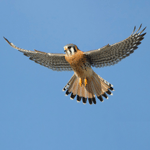
USFWS Falcons are the speed-demons of the hawk world. Although by far not the largest of hawks, falcons are hard to ignore. In Redwood National and State Parks, the tiny American Kestrel (Falco sparverius) is a “paint-by-number” bird, with colorful head and facial patterns, and either solid orange back and wings (female) or orange back with bluish wings (male). Kestrels often perch on wires or posts close to the ground. The Merlin (Falco columbarius) spends the fall and winter months in and around Redwood National and State Parks. Just slightly larger than the kestrel, it is as dark and drab as the kestrel is colorful. However, it is a fierce predator, similar to its larger cousin the Peregrine (Falco peregrinus), and will send flocks of smaller birds scattering as it bombs through. Peregrine falcons, once an endangered species, now thrive in and around Redwood National and State Parks. On almost any sunny day when seabirds or shorebirds are loafing on ocean beaches a peregrine may be observed hunting. Regardless of the species, all falcons may be identified by their sharp pointed wings and very rapid flight. 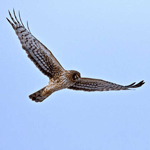
USFWS The Northern Harrier (Circus cyaneus) is the only harrier found in North America. It is a hawk of open spaces and often flies just a few feet above the ground when hunting. In Redwood National and State Parks, Northern Harriers may be seen in valley bottoms or flying low over dunes on ocean beaches and in the Bald Hills grasslands. Its relatively large size and habit of gliding low above ground make it readily identifiable, although it can trick a birdwatcher by occasionally flying high and circling like a buteo or folding its wings and stooping like a falcon. Adult males are slate gray above and females and subadult males are brown above. Both sexes and all ages have a bright white patch on the rump and a longish gray and black banded tail. 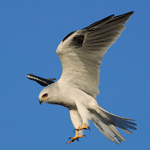
USFWS Kites are named after one of their common hunting practices which is... well...kiting, or hanging still in the wind above the ground. They also will remain in one place and alternately kite and flap their wings to stay aloft. The White-tailed Kite (Elanus leucurus) is the only resident kite in California and may be observed in Redwood National and State Parks foraging above pastures and meadows and in the Bald Hills. It is a slight, slender bird with very pointed gray wings with black shoulder patches. Except for the wing tips it is nearly pure white below. 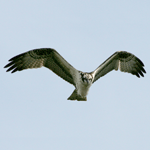
NPS Perhaps the most-commonly observed raptor within Redwood National and State Parks is the Osprey (Pandion haliaetus), also known in some circles as the “fish hawk.” Ospreys build large, visible nests on the very tops of snags or dead-topped trees, power poles, or just about anything high enough for them to have a good vantage point. They feed exclusively on fish and may be seen hovering over large water bodies or transporting a silvery salmon in their talons back to a nest to feed youngsters. Although sometimes mistaken for a Bald Eagle due to its whitish head, Osprey are small in comparison and are white underneath versus the all dark under wings, chest, and belly of the Bald Eagle. 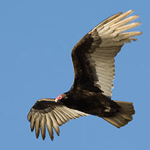
NPS Vultures Vultures are most often classified with the diurnal raptors in field guides and other references. However, the vulture’s place in the taxonomic scheme of things has been a matter of debate. Looking closely, there is really nothing “raptorial” about vultures; they lack the sharp, hooked talons of raptors and they are not predatory, feeding exclusively on carrion. The featherless head of the vulture is believed to be an adaption that better enables it to poke deep inside the carcasses of dead animals. At one point ornithologists were claiming vultures were more closely related to storks than to birds of prey. Regardless of whether a raptor or not, Turkey Vultures (Cathartes aura) are readily visible for most of the year in Redwood National and State Parks. Not as large as an eagle, but larger than most buteos, in flight they may be identified by their teetering glide on wings held at an upward angle from the body, with contrasting dark and lighter gray when seen from below. When perched, the naked red head of the adult is clearly visible at close range. |
Last updated: November 24, 2017
